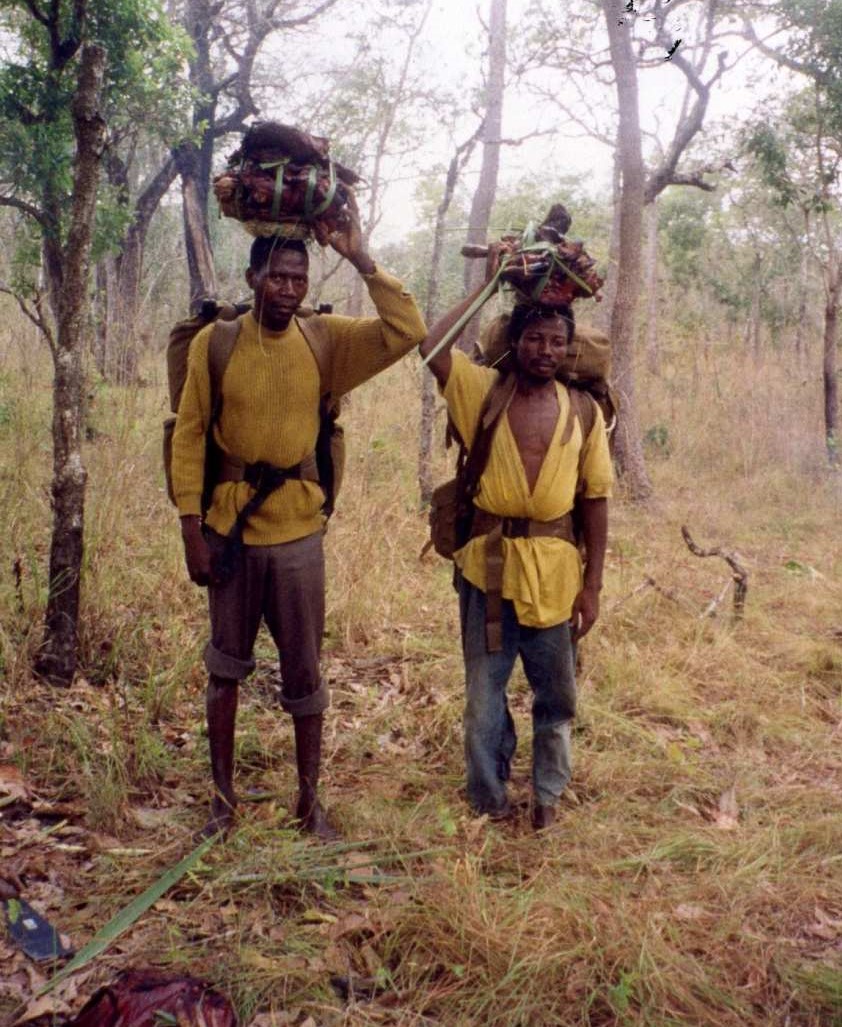You can read through the text below, or listen to the voice recording of the story.
Enjoy!
The night-long flaming and smoking of the reedbuck meat left it almost dry and a deep purple in colour. The men used palm leaves and strips of bark to truss it in tight bundles, which they will carry balanced on their heads.
At the midday break they will probably cure it a bit more, so that it becomes almost black and dry. At breakfast and dinner they will shave off bits to have with their porridge. Not a scrap will go wasted.
It was a sad thing to kill the reed buck, but as sojourns stretch over several days it becomes unavoidable to provide my companions with meat. It relieves the pressure of having to carry food, but more importantly, bush people are unfamiliar with modern foods that are carry-efficient. They will eat some, but mostly they end up eating only the maize porridge.
One would think African bush dwellers are spoilt for choice when it come to meat. The truth is, most are perpetually protein starved. It is hard to kill a wild animal. They are extremely alert and will move away from any human activity. Having a rifle and not getting them some meat is regarded as callous. Meat is part of the package. Until they have meat, I would be targeted with telling looks and glances and quite over-animated and unnecessary pointing out of likely prey animals with, “Ei, that one, it is nice to eat…”
The men showed remarkable balance carrying the meat bundles on their heads. I know African women, who are the main gatherers and carriers of water and firewood in wilderness societies, to carry huge bundles of wood or containers of water on their heads over many kilometres. These loads often weigh more than twenty kilograms, and the wood bundles are unevenly shaped and awkward to handle. Yet they carry them through the bush and along little footpaths that plunge and climb and weave over terrain crowded with vegetation and obstacles. The men seem to have the same ability. These meat bundles are nowhere near that heavy, but the bearers will carry the combination of backpack and meat load through the day, over whatever terrain we encounter.
But we do not hurry; we enjoy the bush, and we try to follow bush paths to ease the going. The African wilderness is veined with them. Some have been made by animals, some by humans. Some are main animal migration routes, hundreds of years old. Some are ancient human trading routes. Others just lead to waterholes or mineral deposits or favourite grazing areas or little bush villages. Some, one can follow for days; others fade out after an hour or so, in the middle of nowhere
Most bush roads are footpath sized – except old elephant paths, which are almost wide and smooth enough to take a vehicle. The paths do not head in a fixed direction. They weave through the veld as if they have minds of their own, seeking out the way of least resistance – bush dwellers of all kinds avoid dangerous or energy-consuming areas like impenetrable thickets, marshy areas, deep ravines, rocky spots, steep places, and so on, when they are on the move.
To use the paths to get to a specific point requires lots of faith, or a guide with local knowledge, or good instinct; actually, all three. But, on sojourns like this I am usually not heading anywhere in particular. The paths’ wanton doodling through the bush suits me – I am sure to get there if I just walk for long enough, as the Cheshire Cat famously taught.
However, I have found that even if I want to get to a specific destination, it is still better to pick my way there along them. I may end up walking a bit further because of the irregular headings they follow, but it is safer, an easier walk and mostly gets me there quicker – and more rested, because I do not need to hack through dense patches, or search for crossings, or retrace my steps because I simply could not get through.

” They carry them through the bush and along little footpaths that plunge and climb through deep ravines and twist-travers rough terrain crowded with vegetation, anthills and obstacles” –
Ja Hoffman, hulle het n wonderlike gawe om items op hulle hoofde te dra en ballenseer, ek verstom my nou nog wanner ek so iets sien.
Mnr, waar parkeer jy jou voertuig as jy soms so lank in die bos wandel, en van plek tot plek loop, jy draai nie terug na waar jou voertuig geparkeer staan nie
Groete
Anna-Mari Meiring
” They carry them through the bush and along little footpaths that plunge and climb through deep ravines and twist-travers rough terrain crowded with vegetation, anthills and obstacles” –
Ja Hoffman, hulle het n wonderlike gawe om items op hulle hoofde te dra en ballenseer, ek verstom my nou nog wanner ek so iets sien.
Mnr, waar parkeer jy jou voertuig as jy soms so lank in die bos wandel, en van plek tot plek loop, jy draai nie terug na waar jou voertuig geparkeer staan nie
Groete
Anna-Mari Meiring